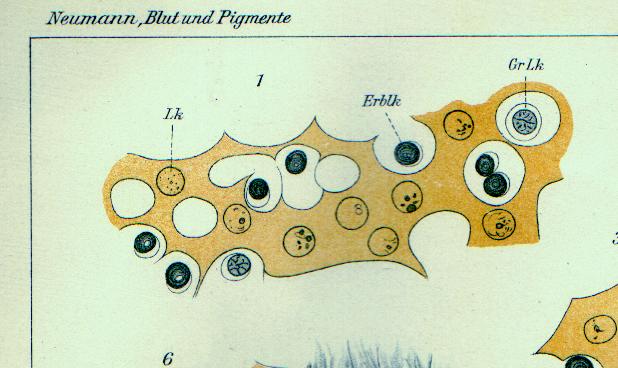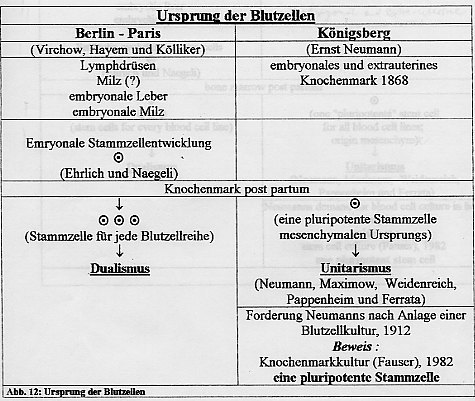|
|
|
|
||||||||||||||||||||||||||||||||||||||||||||||||||||||||||||||||||||
In addition to Rosenow, Wintrobe and Tavassoli, the german hematologist Günther Brittinger and Herbert Neumann (see button rediscovery) considered Ernst Neumann as one of the famest hematologists in the 19.th century (see button Ernst Neumann, Cytology and Rediscovery). History of the Stem cell 1868 - 1914 Koenigsberg/ Prussia E. Neumann This
"Lympoid marrow cell"
forms not only the erythrocytopoiesis but it is capable (in itself) to self regeneration. 1869, BP. Side 30 - 34 . “In order of the size differences of the lymphoid marrow-cells, we will be right in thinking that a permanent fluctuation will take place in the bone marrow" (BP p. 30).
1912: Until 1912 Neumann called the stem cell "lymphocyte", "great lymphocyte" or "Lymphomyeloblast". Since that time, he declares: Neumann was advocate of the Unitarien Point of View:
All blood cells shall be descended from this post embryonic stem cell.
As it is well known, a quarrel broke out between dualists and unitarians (P. Ehrlich). Neumann's
farsightedness demanded a stem cell culture for the completion of the quarrel: This passage earned a great mention in the book
of H. Neumann and Y. Klinger - see below
1914 Where does the stem cell comes from? Neumann answered: "We have the right, to think that the stem cells in the bone marrow are descended of the Reticulum-cells ." N 119, 1914, BP, p. 362 http://www.gelehrtenfamilie-koenigsberg.de/Uebersicht__Gelehrte_u._Kuenstler.html
Literatur: Neumann, E.: Blut und Pigmente. Jena Gustav Fischer 1917
Tavassoli, M.; Yoffey, J.M. : Bone Marrow; Structure and Function. Alan R.Liss, Inc., 1983 New York Zech,N.H., Shkumatov,A. Koestenbauer,S.: Die magic behind stem cells. Journal of Assisted Reproduction and Genetics Vo. 24, Nr. 6 (2007) 208 - 214
|
| [welcome] [Ernst Neumann] [Pathology] [Hematology] [stem cell] [Cytology] [Award] [Literature] [Archive] [celebrations] [Rediscovery] |

